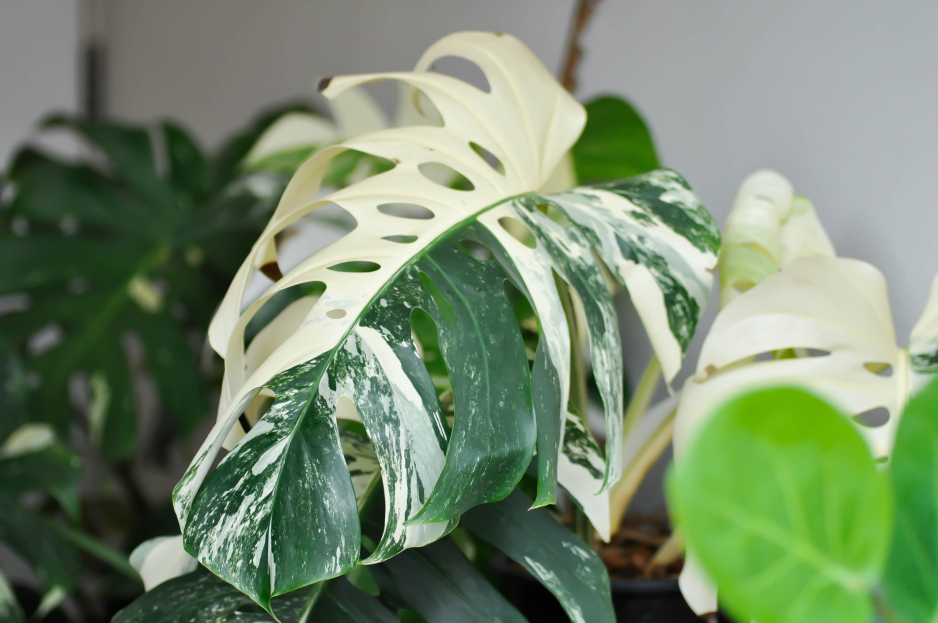
The Monstera Albo, also known as the Monstera deliciosa 'Albo Variegata', is a stunning and highly sought-after houseplant that features striking white or cream-colored variegation on its large, glossy leaves. This beautiful plant is a variation of the classic Monstera deliciosa, but with the added bonus of unique and eye-catching leaf patterns. Caring for the Monstera Albo can be a bit more challenging than other houseplants due to its specific needs, but with the right care, it can thrive and reward you with its stunning foliage.
Here’s everything you need to know to care for your Monstera Albo and keep it looking its best.
The Monstera Albo thrives in bright, indirect light. The variegated leaves need sufficient light to maintain their beautiful patterns, but direct sunlight can scorch the delicate white areas of the leaves. A location near a window with filtered light is ideal. If the plant receives too little light, it may lose its variegation, and the leaves could become entirely green. However, too much direct sunlight can cause the white areas to burn, so be mindful of its placement.
If you're growing your Monstera Albo indoors, try placing it near a north- or east-facing window for the best light conditions.
Monstera Albo plants prefer moderate watering. Like most tropical plants, they don’t like to sit in soggy soil, so it’s important to ensure proper drainage. Water the plant when the top 1-2 inches of soil feel dry to the touch. During the growing season (spring and summer), this will typically be once a week, while in the dormant months (fall and winter), you may need to water less frequently.
It’s important to avoid overwatering, as this can lead to root rot. Always ensure that the pot has drainage holes to allow excess water to escape. If the plant is sitting in water, it may develop issues such as yellowing leaves or root rot.
Monstera Albo plants prefer warm and humid environments. They thrive in temperatures between 65°F and 85°F (18°C to 29°C). Avoid placing your Monstera Albo in areas with cold drafts, such as near air conditioners or windows that are frequently opened during winter, as this can stress the plant and stunt its growth.
In addition to warmth, Monstera Albo plants also enjoy higher humidity levels. Aim for a humidity level of 50% or higher. If you live in a dry climate or during the winter months, you can increase humidity by using a humidifier, grouping plants together, or placing the plant on a humidity tray with pebbles and water.
The Monstera Albo requires well-draining, light and airy soil. A good potting mix for this plant would be one that contains a blend of peat, perlite, and orchid bark, which will allow for good drainage while retaining some moisture. You can also add a small amount of charcoal or sand to the mix to help with drainage.
When choosing a pot, ensure that it has drainage holes to prevent water from collecting at the bottom, which can lead to root rot. Repot the plant every 1-2 years, or when the roots outgrow their pot. Monstera Albo plants tend to grow quickly, so they may need a larger pot to accommodate their expanding root system.
Monstera Albo plants benefit from regular feeding during the growing season (spring and summer). Use a balanced liquid fertilizer that is diluted to half strength. Fertilize the plant once a month during the growing season to encourage healthy growth. Avoid fertilizing during the dormant months (fall and winter), as the plant’s growth slows down during this time.
It’s important not to over-fertilize, as this can lead to nutrient burn or damage to the plant. Always follow the instructions on the fertilizer packaging and be sure to flush the soil occasionally to prevent the buildup of salts.
Monstera Albo plants can grow quite large, so pruning is often necessary to maintain their shape and size. Trim back any long or leggy stems, and remove any yellowing or damaged leaves to keep the plant looking tidy. Regular pruning also encourages new growth and can help the plant develop a bushier appearance.
Since the Monstera Albo is a climbing plant, you can provide it with a moss pole or trellis to support its growth. This will allow the plant to grow upward, mimicking its natural environment. As the plant grows, you can train the stems to climb the pole by gently tying them with soft ties.
One of the best things about Monstera Albo is that it’s relatively easy to propagate. To propagate, take a stem cutting that includes at least one node (the small bump where a leaf or root grows). You can propagate the cutting in water or directly in soil.
To propagate in water, place the cutting in a jar or vase with water, ensuring that the node is submerged. Change the water every few days to keep it fresh. Once roots begin to form (usually after 2-3 weeks), you can transplant the cutting into soil.
Alternatively, you can propagate the cutting directly in soil by placing it in a small pot with well-draining soil. Keep the soil moist and place the pot in a warm, bright spot. After a few weeks, the cutting should begin to root and grow.
Unfortunately, like many other types of Monstera, the Monstera Albo is toxic to pets. It contains calcium oxalate crystals, which can cause irritation to the mouth, throat, and digestive system if ingested by pets. If you have cats, dogs, or other pets that may be tempted to nibble on your plant, it’s best to keep the Monstera Albo out of their reach.